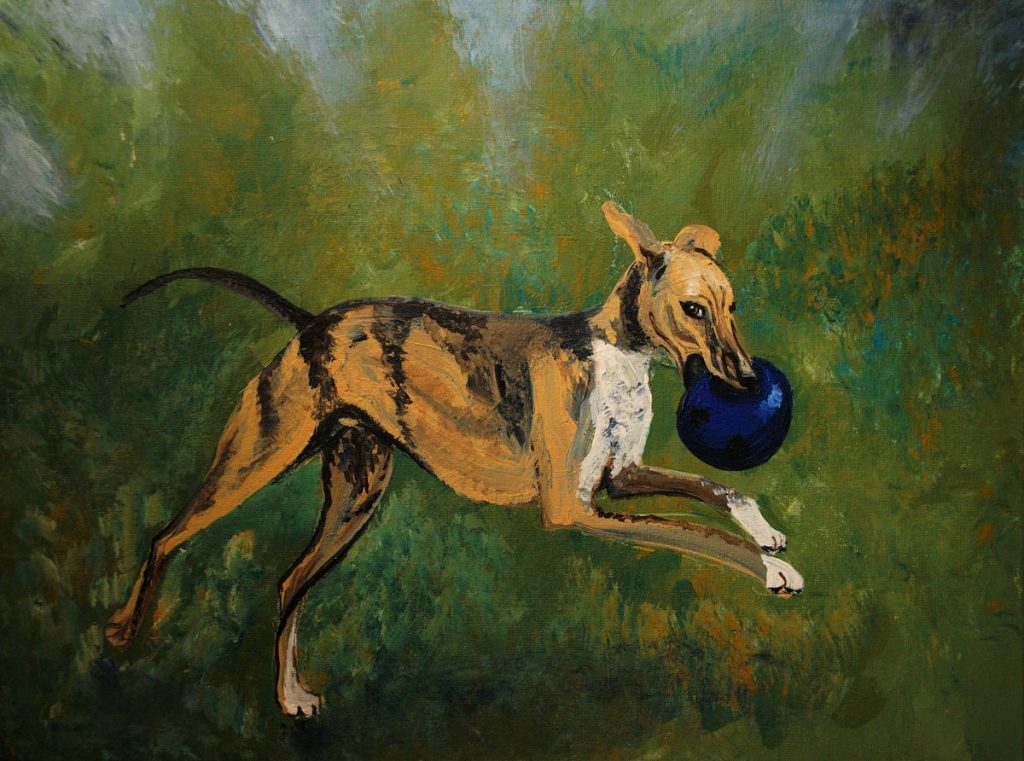Above, a selection of my own hounds through the years, plus Tolkien’s Huan.
A wingless Dragon – a bit pretty to be Glaurung?
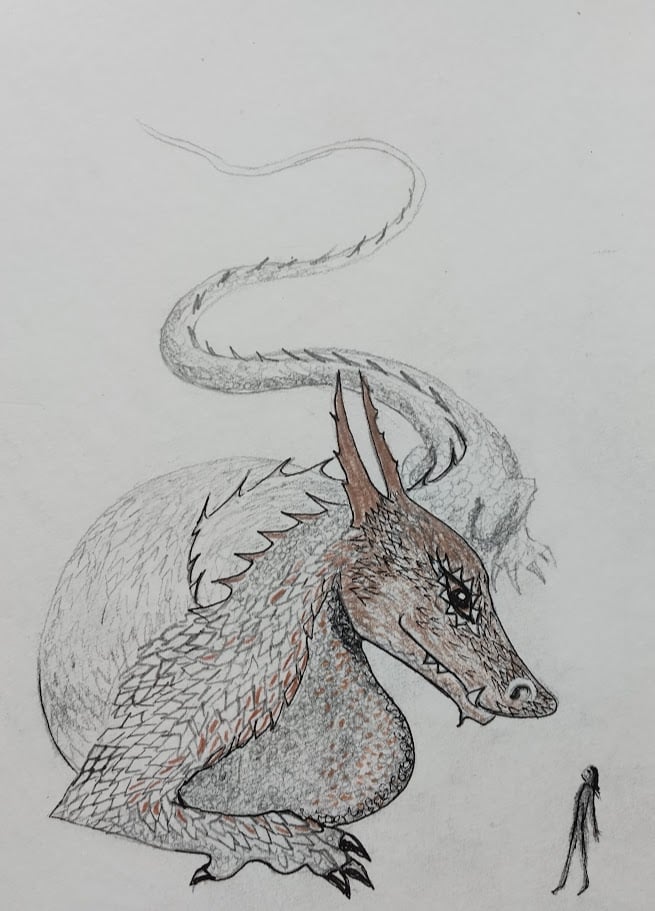
Fantasy, Tolkien, Pembrokeshire, Cornwall, Hounds
Above, a selection of my own hounds through the years, plus Tolkien’s Huan.
A wingless Dragon – a bit pretty to be Glaurung?

I need to put a featured image on this post, and I think this is the best of the three, BUT please bear in mind that it’s absolutely tiny: small-postcard size, so it may look a bit iffy if you are seeing it emblazoned across a screen much wider than the original 4 x 6 inches. But of course they all look the same size once they are photographed!
This one is an A4 painting, so a bit larger, and drawn from life: Theo harehound having an evening nap.
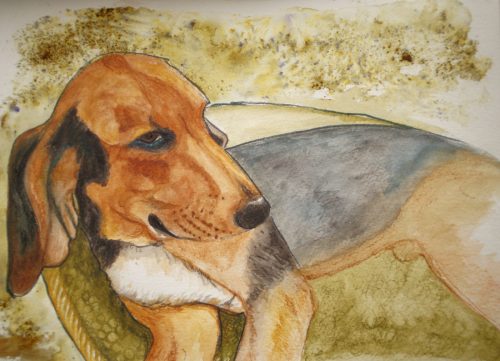
Finally! Here is another tiny postcard, this time a picture of our white cat, Nenya. 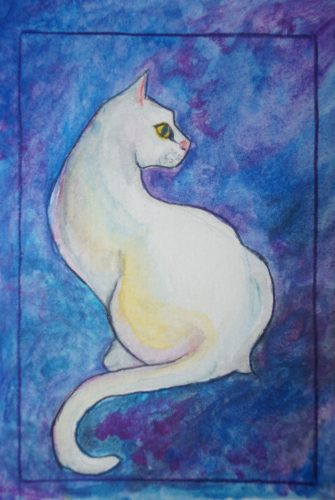
My saluki x Rosie Roo on a frosty Christmas day morning. Above is version 2, where I have adjusted her face a little, made some small lighting amends, and taken a new photograph. It’s surprising the difference that makes.
My original idea of a dog glowing with the winter light behind her, which I think looks perhaps a little flat by comparison (and definitely has the wrong eyes!)
And here is a smaller A4 painting of my Greek Harehound pup, Theo. He’s seven months old and surprisingly chill: he likes to watch the world going past as well as haring around like a loon. I didn’t like the background of the photo this was taken from, so I’ve added a woodland scene.
I spent some time experimenting with dry Brusho watercolour pigment powder, ink pencils, and spray inks. The picture above was I think the most successful, but I thought I’d upload some of the other works to record how I approached them.
The painting with the deer, above, I started with light. I used a spray bottle of yellow ink to make a spot of yellow in the middle of my picture that faded to white all around, and then a very small spray of red ink around it to create a slight darkening/reddening around the edges. Once that was completely dry (vital so the ink would not run! Ink stays put once it’s dry (mostly) whereas watercolour can be re-wetted and will run and move more.)
I painted the top of the image with plain water, and added Leaf Green brusho pigment to the top of the wet area. Then I sprinked Moss Green and Sandstone pigment at the bottom of the wet area, stood the picture up vertically, and dripped water here and there so that the wet pigment ran in mingled streaks down across the dry yellow ink sunburst.
The painting below was created in the same way, but without the ink sunburst: this was my earlier draft. It’s still quite a pleasing thin forest, I think.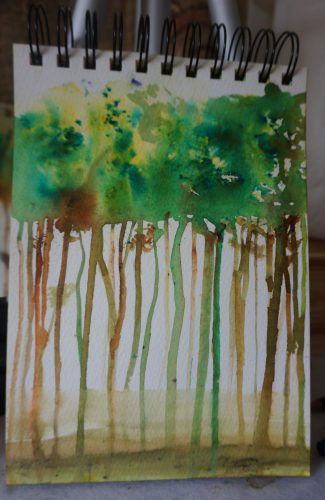
I love the way the Brusho pigment makes random patterns and speckles of light when applied to wet watercolour paper. (You do need a thick good quality watercolour paper for this kind of thing, so the paper doesn’t crinkle.)
I brushed the pigment across the bottom with a wet brush, just to create a foreground, and added a little more moss green foliage at the bottom.
Then, once the trees and grass were dry, the last step was to draw a deer. I used a purple Inktense pencil for that, and then carefully washed over it with water. This allowed some of the yellow ink to show through the purple layer, and re-wetting the Brusho trunks underneath the deer gave the purple a good varied colour so it sat well with the rest of the picture rather than looking stuck on.
I tried the same idea here, but without the yellow ink undercoat and with a figure instead of the deer, but it didn’t work quite so well.
Before I started playing with the idea of drips forming trees, I first tried them creating the under-water stems of water-lilies. I think this would have worked a little better if I had given the lilies a bit more space and drawn them out more carefully. 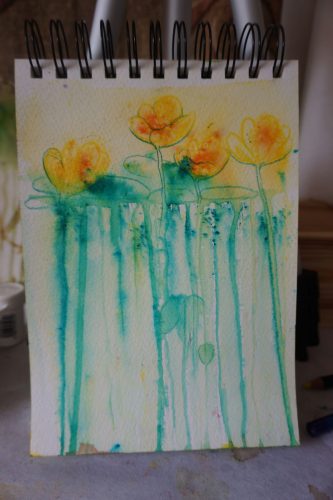 This was my first attempt at putting the Brusho colours onto wet watercolour paper, and then tilting the paper to make the pigments combine. It’s 100% abstract, but I rather like it. That’s how I ended up with the idea for the lilies.
This was my first attempt at putting the Brusho colours onto wet watercolour paper, and then tilting the paper to make the pigments combine. It’s 100% abstract, but I rather like it. That’s how I ended up with the idea for the lilies. 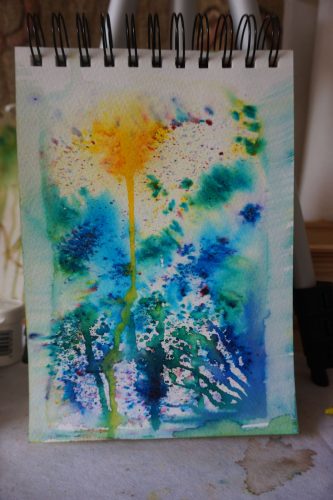
And finally (this post is all the wrong way around) this is the first picture I made in this session. I drew the dog first, using Inktense pencils, then I masked over her with a liquid rubber mask. Then once the mask was dry, I water-painted the whole thing and started applying a mix of dry brusho powder to see what would happen. What happened was quite colourful!
This is something of an experiment. I had a big frame where the back panel had got damaged, but the frame & perspex were fine, so I tried some peelable glass paint and made this design on the perspex. I like the way it changes with the background and the light! You can see it looks quite different in this second picture:
Subject is, of course, my beloved saluki lurcher Rosie, from Lurcherlink rescue. Because painting on a transparent sheet where light comes through the paint itself is pretty demanding in terms of how the brushstrokes look, I drafted this out in advance using coloured pencils.
Finally: this is the window that I originally bought the glass paint for!
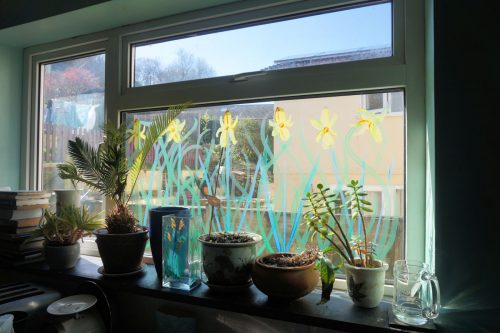
Because it’s peelable, I can just take it off and replace with something else if I get bored of it.
I mostly paint in acrylics, but I decided to experiment with mixed media for these paintings.
Wood-elf
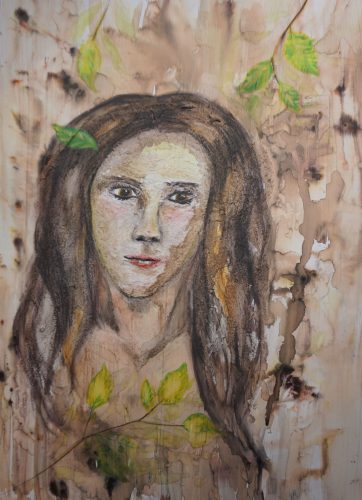 This intense-looking elven lady is almost a sculpture as well as a painting: I made her face in acrylic sculpting paste, and then coloured her with brusho pigment and watercolor pencils.
This intense-looking elven lady is almost a sculpture as well as a painting: I made her face in acrylic sculpting paste, and then coloured her with brusho pigment and watercolor pencils.
This next peacock used brusho pigment and watercolor pencils too, though he’s flat on the paper, no sculpting paste this time!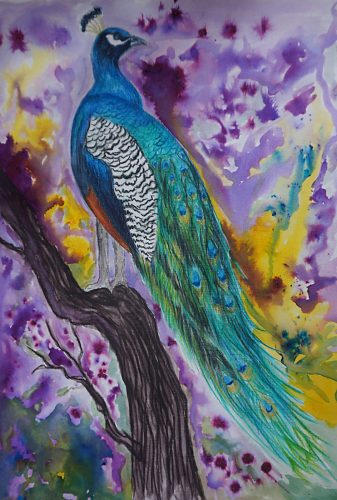
Here are two images where I used ink and brusho. The first painting is of one of my cats: I painted the cat first, then added brusho and some sprayed ink.
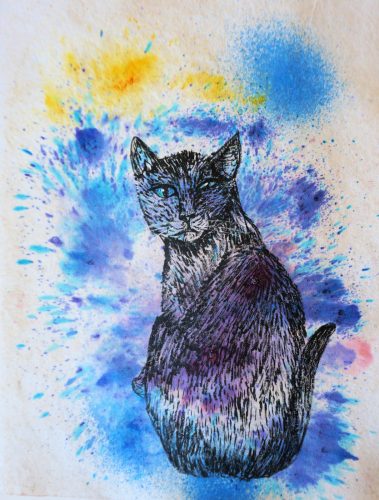
This one, I applied brusho to the paper, then added some cheerful dancing ink figures. 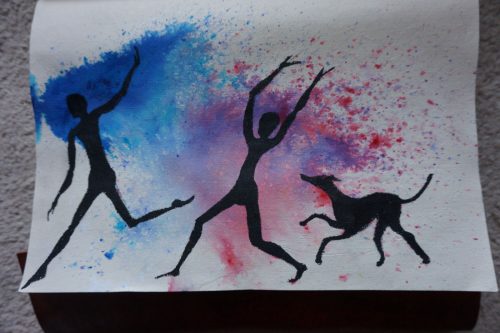
One of the most beautiful things about sighthounds are their huge eyes, and my rescue lurcher Rosie is no exception. I was out walking her a couple of days ago, and wondered what she would think I should paint, if she understood the idea. The answer was obvious: Squirrels! Squirrels are very important! So I thought I’d try creating an image to show off both her eyes, and her love of squirrels.
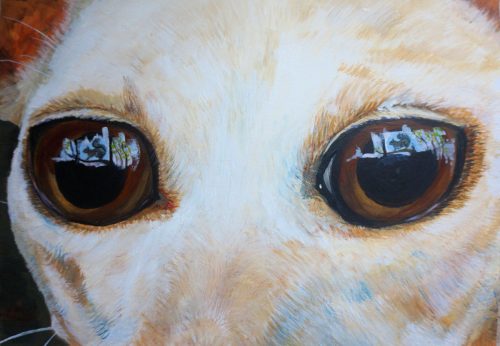
Here’s another of my animals, Gothmog Kitten. She’s about six months old now, and very playful: she loves to steal packing peanuts. They are just the right size and texture to be bopped with a paw, or carried around the house.
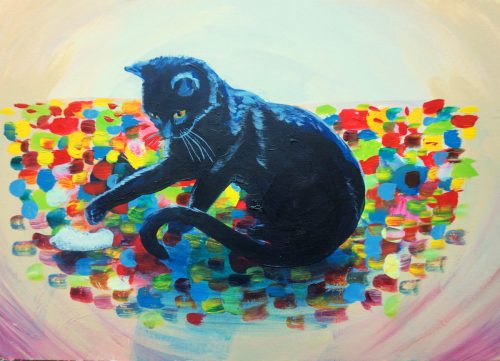
Not the easiest thing to paint black fur, but an interesting challenge.
My first ever sighthounds : Az, on the left, a whippet x greyhound lurcher, and Mollydog on the right, a retired racing greyhound. They say that greyhounds are lazy sleepy dogs, but I don’t think anyone had ever told Molly that, she was always up for a game and loved long walks!
This is a fairly small acrylic painting on canvas, and because I experimented with a gloss glaze over the dogs (but not the background) it’s photographed rather oddly. I should probably rephotograph, sorry about that!
This painting was originally created as a ‘fifty brushstrokes’ exercise, to help me think about how to use a single stroke to create an effect. I rather liked it, so I developed it further.
This is Brythen, a brindle saluki mix lurcher I adopted from Forever Hounds Trust. Sadly, Brythen died relatively young last year at the age of only seven, but I have many photos and wonderful happy memories of him. This was painted from a photo of him playing with his favorite blue saggy football in the garden. I think I’ve caught the naughty glint in his eye! 